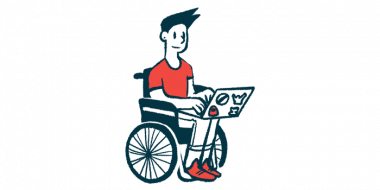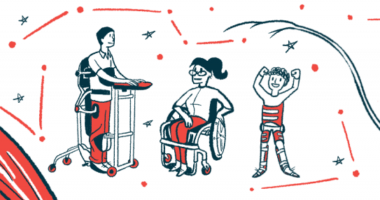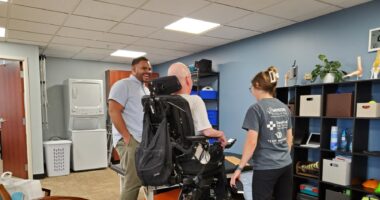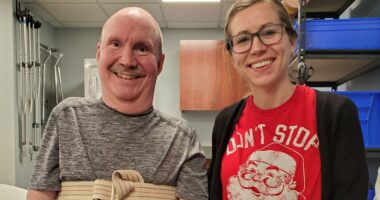Coccyx mobilization techniques can provide relief for SMA patients
Moves can help reduce pain and improve tolerance to long periods of sitting

Many patients with spinal muscular atrophy (SMA) spend the majority of their time sitting in wheelchairs. Increased periods of sitting can lead to tailbone pain due to increased pressure on those areas. When these areas become stiff and painful, a little mobilization can lead to reduced pain and improved tolerance to prolonged sitting.
For some of these patients, weight shifting is difficult, although necessary to reduce the risk of pressure ulcers. To improve mobility of the areas and reduce pain, there are a few different techniques we have performed with Michael, our patient who has SMA.
The first technique we utilized was the stuck drawer technique. This is performed by sitting with one hand under the patient on the coccyx while the patient performs lumbar flexion and extension, and tightening of the pelvic floor to help with mobilization.
Since Michael doesn’t have full active range of motion of his lumbar spine, this requires a second person to lead him through those motions while the other is mobilizing the coccyx externally. This technique gave Michael a moderate amount of relief while sitting and reduced tingling and numbness that radiated down his leg. This was performed every other week to maintain the effects.
The second technique performed was a side-lying external coccyx mobilization with activation of the pelvic floor, performed to increase coccyx movement. This was performed on the large therapy mat with Michael lying on his left side with support between his legs and under his head. As I would add traction superiorly toward Michael’s head, he would relax, and as I would apply traction inferiorly toward his feet, he would perform a pelvic floor activation.
In this position, I also began to target coccygeus musculatures, or muscles along the coccyx, and begin to release them on the left side, as Michael’s coccyx tends to migrate toward that side. With this technique, he felt a substantial amount of relief from numbness in his legs and pressure on his tailbone.
The most recent technique we have performed has been an internal coccyx mobilization. This was performed with Michael lying on his side with support between his knees and under his head. With permission, one finger was inserted into the rectal canal and the coccyx was located. While Michael performed pelvic floor activation contractions and bulging, I was able to locate and feel how the coccyx was moving.
A soft tissue mobilization called sweeping was performed along the left coccygeus musculature, alongside the coccyx, to release those tissues and attempt to bring the coccyx more into midline. We are unsure of the longevity of the relief with this technique due to how recently it was performed, although Michael had no pain after the activity.
Depending on how much relief Michael receives from these activities will determine which ones we perform and how often they are needed. We will continue to monitor and keep track of the time frame of relief experienced with each activity. This will help guide our future treatments and treatment plans.
Patient perspective
About a year ago, while working on range of motion and flexibility exercises, Emily noticed that when she stretched my legs in a downward motion, I was grimacing. She asked me if I was in pain, and I told her that I was experiencing quite a bit of pressure toward the upper parts of my glutes when she performed this particular exercise.
She rolled me onto my left side and placed her hand on my lower back. As she moved her hand down toward my glutes, she found that the pressure that I was feeling was coming from my tailbone. As she applied pressure on my tailbone, we realized that this may have been the cause of me not being able to sit comfortably for long periods of time. In her part of the article above, Emily details the the different techniques that we’ve used during the past year.
A few weeks ago, Emily told me that she could probably get better results if she could perform an internal examination, because this would allow her not only better access to my coccyx bone, but she could also apply pressure with her other hand on my tailbone. She asked me if I would be comfortable with her performing this procedure on me, and I immediately agreed with her assessment. Yes, this was going to be somewhat embarrassing, but I concluded that a few minutes of embarrassment would be worth the long-term impact that I could possibly see.
I’ve said numerous times in previous articles that the patient and physical therapist relationship must be one of trust. Emily and I have been working together for more than five years, and she has a unique way of making me feel comfortable with the therapies that we are doing. SMA patients should realize certain techniques may be uncomfortable to undergo from a vanity standpoint, so trusting your physical therapist is crucial. Emily knows more about me than the majority of my immediate family and friends, and there was no hesitation with me agreeing to let her perform this technique because I knew she had my best interests at heart.




